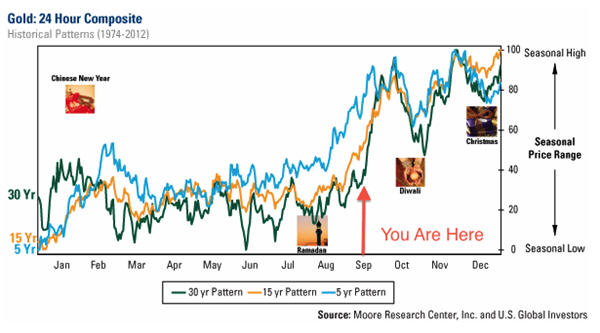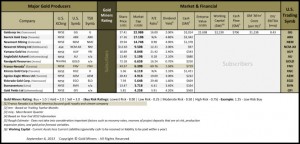Tis’ gold season, get it before it’s gone – Gold Miners Weekly
If you want to know why the price of gold fluctuates on a daily basis, just type www.bloomberg.com or www.cnbc.com into your favorite web browser and you’ll find out.
A recent Bloomberg news story titled, “Gold Climbs as Obama Moves Closer to Approval for Syrian Strike” claimed that gold gained on the day because the Senate Foreign Relations Committee gave Obama the go-ahead for military operations against Syria and therefore, people rushed into gold as a safe haven.
A couple of days before the story mentioned above, Bloomberg published this article, “Gold Futures Decline from Three-Month High on Stronger Dollar”. According to this story, the U.S. dollar rose from speculation that the U.S. will lead an attack on Syria and therefore, people sold gold and rushed into the dollar because of its safe haven status.
Hmmm…
How about this one, courtesy of CNBC, “Gold Falls Below $1,400; US Jobs Data, Syria in Focus”. Apparently, strong U.S. auto sales are a signal that all-is-well with the U.S. economy and since Obama didn’t immediately give the Syria attack order, who needs gold? Sell…Sell…Sell!
Granted, I’m having a little fun, but everyday these types of stories are being published by financial media who are quick to tie daily gold price movements almost exclusively to western related daily news. We think, for whatever reason, that western media outlets are missing the real story behind gold. And we will continue to think so until we see this headline…
“The World’s Two Largest Gold Importing Countries Set New Gold Import Records”
India and China, the world’s two largest gold importing countries by far, have increased their imports by 48% and 70% respectively, when comparing the first half of 2013 to the same period in 2012. These are records for both countries and this is the real story behind gold!
Crocodile Dundee’s Knife and Real Gold Demand
Come on, everyone knows the quote…
“He’s got a knife.” [Says concerned and very pretty love interest, with emphasis]
[Crocodile Dundee chuckles]
“That’s not a knife. [He draws a mini-sword and exclaims] That’s a knife!”
I was reminded of that quote because in today’s missive we focus on the domestic intricacies that drive the enormous demand coming from these two gold import behemoths. And even though we have already seen record gold import numbers this year, we’ve just entered the period when traditionally, gold sees its greatest demand.
Gold has very powerful, and hence very tradable, seasonal tendencies, just like the weather. In fact, these seasonal tendencies are linked, directly or indirectly, to seasonal weather patterns.
There are times of year, in Asia generally, and in India and China particularly, where gold buying gets extremely heavy (cheesy pun intended). It’s these times that are, in aggregate, responsible for gargantuan Asian demand.
These seasonal events can generally be categorized as harvest, wedding, and festival related. However, it would be a mistake to treat them as isolated occurrences as they overlap in meaning and timing.
For example, some festivals are strongly associated with the harvest, and weddings are planned to coincide with festivals to invite a blessing on the union.
Understanding the dynamics that drive demand in the world’s largest gold importers is critical for investors looking to profit in the gold sector. Ironically, it is our experience that this is an area in which most gold sector investors are either woefully unaware or underestimate its significance.
With that said, let’s get a handle on these seasonal events and the best times of year for gold investors. We’ll start with the best seasonal time to buy gold, which as you can see by the arrow on the chart below, is now! (Credit for the chart goes to Moore Research and U.S. Global Investors)
Crops for Gold Please (Late August – Late September)
Hooray! We’re in harvest season! And for India, a record one at that!
According to The Economic Times, favorable growing conditions have prompted Indian farmers to plant approximately 7% more crops than last year. Reasonable expectations are that bumper yields will be harvested and will increase farmer’s profits.
Traditionally, farmers have exchanged a healthy chunk of their profits for gold because in rural areas, there isn’t a Wells Fargo on one corner and a Bank of America on the other. More profoundly, Indians have been buying gold as a reliable way to store and preserve wealth for millennia.
Approximately 60% of Indian gold demand comes from rural areas and 70% of the Indian population resides in rural areas. I don’t know about you, but I haven’t seen that many farms in the city, which leads me to the conclusion that farmers live in rural areas.
And, with the likely prospect of a very promising harvest, it is reasonable to believe that Indian gold demand will be strong through harvest season as rupee’d up farmers will be eager to exchange their profits for gold.
The Mid-Autumn or Moon Festival is celebrated by the Chinese and the Vietnamese and time-wise, is similar to the Indian harvest season. The festival has three fundamental components; gathering with family and friends, giving thanks for the harvest, and praying for material satisfaction.
Similar to Indians, the Chinese are also committed savers and like to save their money in gold. This, in conjunction with the Indian harvest festival, makes for strong gold demand at this time of year.
According to gold seasonality expert, Adam Hamilton from Zeal Research, the harvest season is the second best seasonal time to buy gold. His research has uncovered that between 2001 and 2011, in the month of September alone, gold has rallied on average, 3.2%.
Festivus for the Rest of Us (November)
Diwali, also referred to as the “Festival of Lights” due to the small, oil filled, clay pots Indians light on fire to symbolize the triumph of good over evil, is a strong contributor to Indian gold demand.
During Diwali, Indian’s buy gold coins and jewelry to adorn the Goddess Lakshmi, the Hindu goddess of wealth and prosperity. Diwali also marks the beginning of the Indian wedding season. This year, the all-important festival begins on the 3rd of November.
In addition, you may be aware that Indians take weddings very seriously. And if you are getting married, either by choice or by arrangement, you do it during the festival season because it’s said to increase the marriage’s chance of success and happiness.
The wedding season is important for gold investors to be aware of because it’s reportedly responsible for 40% of India’s gold demand. Many of you have undoubtedly seen pictures of an Indian bride. She’s quite the site to behold.
On her wedding day, she is lavishly overlain with intricate gold jewelry work. The gold serves to both enhance the bride’s beauty and provide a dowry; giving her financial strength, standing, and insurance in her new family.
This year, India’s gold imports have already seen record numbers. When you consider that 40% of gold demand is still to come, their total number for the year could simply be enormous!
Not surprisingly, November is the best calendar month of the year for a gold price surge, recording an average increase of 4.6% (again from Adam Hamilton of Zeal Research).
What do Turkey, Christmas, and the Lunar New Year Have in Common? …Gold (Late November – Mid February)
Taking over from the Indian festival period is the western gift-buying season, which starts in the wake of Thanksgiving (i.e. black Friday) and extends through Christmas, and the New Year.
Jewelry (e.g. gold) is a popular gift for these occasions and western jewelers do more than half of their business during this time. In Q4 of 2012, U.S. jewelry demand was equivalent to US$2.2 billion according to the World Gold Council.
Taking the gold baton from the west and keeping demand alive into February is the Chinese New Year. This is an important holiday in Chinese culture and as such, is one of the biggest gold buying periods of the year.
We have spent plenty of keyboard time detailing the Chinese affinity for gold. Therefore, we’ll just say here that considering how much gold they’ve been buying this year, regardless of occasion, the Chinese New Year will certainly elevate gold demand!
Ramadan
The final seasonal period we’ll mention is Ramadan. This all-important religious observance is a period of prayer, fasting, donations, and gift giving for Muslims the world over. This year, on the Gregorian calendar anyways, it started at sunset on the 8th of July. Next year (2014) it will start at the end of July.
As mentioned, it is traditional to give gifts during Ramadan and a popular gift, especially in the Middle East, is gold. As an example, this year Abu Dhabi jewelers experienced a 30% rise in sales activity during the period.
Conclusions
Revisiting our introduction, the mainstream financial press doesn’t know why the gold price rises or falls on any given day, although that doesn’t stop them spouting a range of reasons. What we’ve demonstrated today is that there are clear explanations why gold tends to do very well at certain times of year.
Over the course of the current 12-year bull market, gold’s positive gains during each individual year are strongly correlated with the seasonal factors outlined above. Investors that took note of these seasonal patterns and invested accordingly, have done very well over the last decade.
Keep this in mind the next time you see articles like the ones we highlighted in our opening. Or better yet, check out the News Corner on our homepage. Every morning we identify and summarize news stories that more accurately highlight meaningful supply and demand factors in the gold market.
Considering the annual events discussed above, the best times to go long gold are before the seasonally strong months of November, September, and May respectively. We are currently entering the harvest, wedding, and festival season in India, which has traditionally been the period of time where gold demand is strongest.
It has already been a record year for Indian and Chinese gold imports. However, with 40% of India’s demand still to come from the festival and wedding season, the gold price typically has a powerful tailwind behind it.
And you know what a rising gold price means. That’s right, higher share prices for our beloved gold miners. So check out our Gold Miners Comparative Analysis Table below.
It’s a brief sample of a much more comprehensive version developed for our subscribers and a powerful tool to help discern which companies are poised to leverage a rising gold price.
(Click the image to enlarge)
That’s it for this week and thanks for reading!
Regards,
RJ Wilcox
{{ commodity.name }}
{{ post.title }}
{{ post.date }}




Comments
Waz
Many thanks Mr Wilcox, didn’t know about some of the festival that drive Gold price action. Thanks again for sharing. Blessings Waz